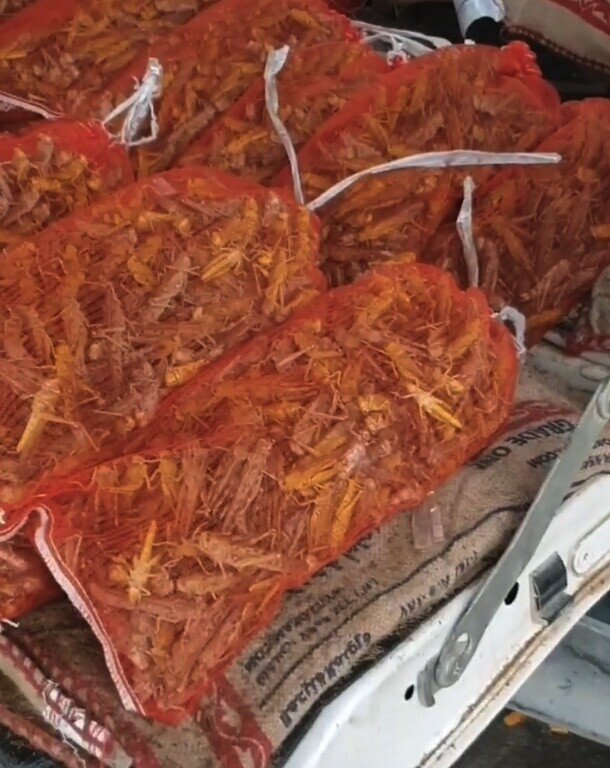Is Eating Locusts Useful to Overcome the African Crisis?
An outbreak of desert locusts in northeast Africa is eating away at crops, causing food shortages for nearly 12 million people. Qu Donyu, Director-General of the Food and Agriculture Organization (FAO) of the United Nations, said on Jan. 30 that the upsurge would "provoke a humanitarian crisis."
However, in 2013, FAO published a report on "edible insects," including desert locusts. Will eating crop enemies help us overcome the crisis?

Desert locusts in Yemen (source: FAO)
Experts say it is difficult.
"I often get this question," wrote Arnold van Huis, a professor at Wageningen University in the Netherlands and one of the authors of the FAO report on edible insects. "Forget about eating them as a control measure."
There are two reasons. First, locusts are often contaminated and unfit to eat. When locust outbreaks have occurred in the past, pesticides have been used to reduce them efficiently.
Dr. Allan T. Showler of the U.S. Department of Agriculture, who worked on locust control in Africa in the 1990s, said he saw people collecting locusts after killing them by pesticides. Trucks heavily contaminated with the pesticides have brought them to markets.
"So we told the governments of these countries, 'You should do something about this, this is very dangerous,'" Showler said. "In many countries, they made it illegal to sell desert locusts for food in the markets during plagues."
Secondly, the locust swarms are too big. FAO reported that a flock in Kenya is 60 kilometers long and 40 kilometers wide. "To catch such a swarm is nonsense," Huis wrote.
Showler also explained that eating them doesn't have a significant impact. He said people can't afford to avoid using pesticides to eat them.
"If those locusts are swarming in farm areas, the government will spray them immediately," Showler said. "They will not wait for a farmer to collect locusts for eating."

Movie: Locusts for sale at a market
The idea of eating locusts to reduce damage is "not new," said Dr. Mohamed Abdellahi Ebbe, Director-General of the CILSS Sahel Institute, Mali, who is working on locust problems. People have been considering using giant machines to suck them up.
But Ebbe believes this is not realistic.
After spending its nymphs life with the crowded environment, desert locusts develop into adults with longer wings than usual. They can fly far in groups, causing great damage.
"It's the matter of when and how early you intervene to capture locusts," Ebbe said. "Non-professional people are dealing with just cooking insects and hunting them. They don't have all this knowledge about the distribution of the breeding area in their countries, and which generally may be located in very far and remote areas."
Still, locusts are excellent food. It would be beneficial to eat them to make up for the loss of nutrients.
Showler, an Arabian American, ate dried locusts when he was a child. People cook them in various ways, such as grilling and roasting. In the French-speaking area of North Africa, they call locusts "Crevettes du Sahara," which means shrimps of the desert, because the taste is similar. The FAO report also noted that Native Americans who habitually ate locusts and crickets reportedly named shrimps "sea crickets" when they first ate them.
Movie: Locusts being boiled in a pot
Africans and Native Americans are not the only ones who eat locusts.
The book of Leviticus states that people are allowed to eat locusts. According to the FAO report, the species mentioned here is most likely the desert locusts, which is causing damage today. Locusts were actually eaten in the fertile crescent where Israel is now located. People in the West might have lost interest in eating insects after agriculture made food production stable, the report explains.
If you are interested in consuming them, be careful.
Eating without removing their spiny hind legs can cause constipation, according to the FAO report that cited a paper in 1945, which is about observations in the Democratic Republic of the Congo. Surgery to remove the clogged legs from the gut is the only treatment.
Researchers try to make them easier to eat.
Dr. John Nduko of Egerton University, Kenya, and his colleagues published a paper in 2019 stating that they were able to make millet flour with a higher protein content that was easy to digest by adding dried and crushed desert locusts. "Locusts and grasshoppers could be incorporated into existing staple foods to generate highly nutritious products that could be recommended to fight malnutrition," they reported.
この記事が気に入ったらサポートをしてみませんか?

